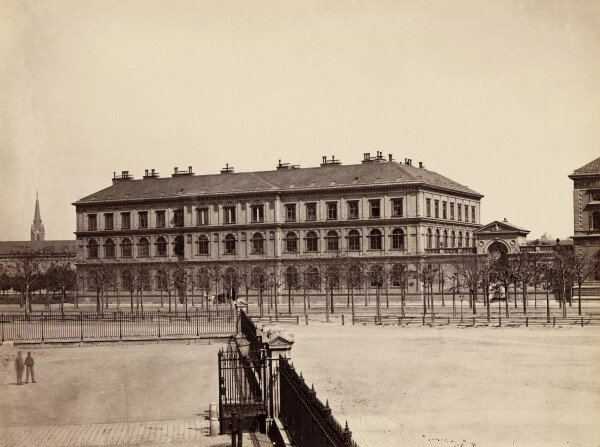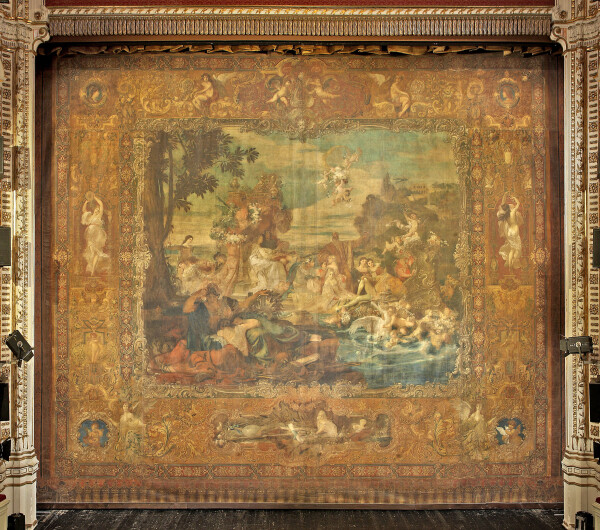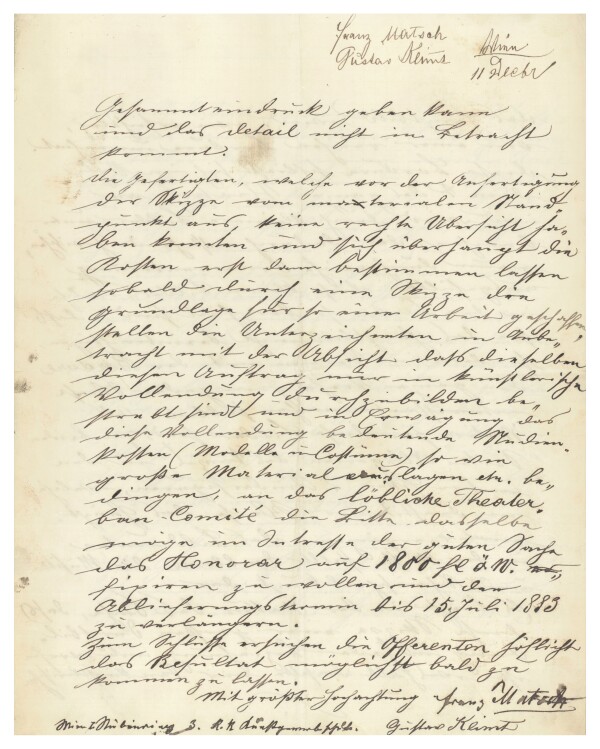Studio on Stubenring

Imperial and Royal School of Arts and Crafts, around 1880
© Wien Museum

Gustav Klimt, Ernst Klimt, Franz Matsch: Allegory of Merry and Solemn Art, 1882/83, F. X. Šalda-Theater
© Divadlo F. X. Šaldy

Franz Matsch: Letter from Franz Matsch in Vienna to the Theater Construction Committee in Reichenberg, co-signed by Gustav Klimt, 12/09/1882, SOkA Liberec, Archiv města Liberec (AML)
© SOkA Liberec, Archiv města Liberec (AML)
After graduating in 1881, Gustav and Ernst Klimt as well as Franz Matsch stayed on at the School of Arts and Crafts of the Imperial-Royal Austrian Museum of Art and Industry (now MAK) for another two years. The school provided the artists, known as “Künstler-Compagnie,” with a studio to work on their commissions.
By 1878, Gustav Klimt, his brother Ernst and Franz Matsch had almost completed their training as drawing teachers at the Imperial-Royal School of Arts and Crafts. The teaching staff, who had noticed the young artists’ talent, helped them to advance via a scholarship to the special drawing and painting class, so that they might train as decorative painters.
The three artists joined forces as a studio collective, commonly known in Klimt research as “Künstler-Compagnie.” Their professor Ferdinand Laufberger repeatedly asked them to carry out auxiliary work for his own commissions. To this end, the Klimt brothers and Franz Matsch were given access to a studio within the building of the Imperial-Royal School of Arts and Crafts, at Stubenring 3, latest in the early 1880s.
For Julius Victor Berger, who succeeded Laufberger after his sudden death in 1881, the three artists worked on the ceiling paintings for the palace of the banker Wilhelm Zierer at this school studio. At the same time, they also participated in the portfolio Allegorien & Embleme [Allegories & Emblems] – a main pattern book of Historicism.
The young artists became increasingly autonomous in their work, and subsequently used their school studio also for their own commissions, which they mostly received through the architectural office Fellner & Helmer.
The largest commission the three painters carried out at their school studio involved the five ceiling paintings and main curtain for the municipal theater in Reichenberg (now Liberec). The majority of the correspondence with their commissioners was sent to the studio address at Stubenring 3, illustrating that the artists’ group was officially allowed to use the school studio also for external projects.
The decoration of Reichenberg municipal theater helped the young painters to win public renown. Along with the numerous newspaper articles about the commission, the completed ceiling paintings, as well as the main theater curtain, were presented to Viennese audiences at the Imperial-Royal Austrian Museum of Art and Industry at the behest of the museum’s director Rudolf Eitelberger. The significance of this exhibition for the success of the “Künstler-Compagnie” is illustrated by a letter to the Reichenberg municipal authorities, in which the artists asked for the delivery date of the main curtain to be delayed so that it might be exhibited in Vienna.
“In closing, allow us, the undersigned, to add that a public presentation of the curtain would be of the highest value to our future as artists – we sincerely hope that the commendable municipal authorities will be so kind as to grant our request [NB: a delayed delivery].”
By the time this commission was completed in September 1883, the artists had managed to make a name for themselves in the art world from their studio at the Imperial-Royal School of Arts and Crafts. That same year, the brothers Gustav and Ernst Klimt as well as Franz Matsch moved into their first independent studio in the 6th District of Vienna, at Sandwirtgasse 8.
Literature and sources
- Herbert Giese: Franz von Matsch – Leben und Werk. 1861–1942. Dissertation, Vienna 1976.
- Sandra Tretter, Peter Weinhäupl (Hg.): Chiffre: Sehnsucht – 25. Gustav Klimts Korrespondenz an Maria Ucicka 1899–1916, Vienna 2014.
- Brief von Franz Matsch in Wien an das Theaterbaucomité in Reichenberg, mitunterschrieben von Gustav Klimt (09.12.1882). VI. – Gd, 202, Signatur 709/4, Karton 188_2, .
- Neue Freie Presse, 27.01.1883, S. 7.
- Neue Freie Presse, 31.01.1883, S. 4.
- Montagsblatt aus Böhmen, 01.10.1883, S. 6.
- Agnes Husslein-Arco (Hg.): Gustav Klimt und die Künstler-Compagnie, Ausst.-Kat., Upper Belvedere (Vienna), 20.06.2007–14.10.2007, Weitra 2007.

